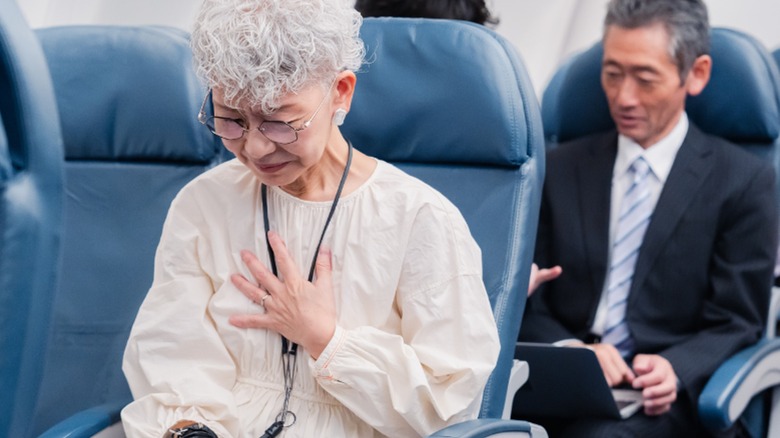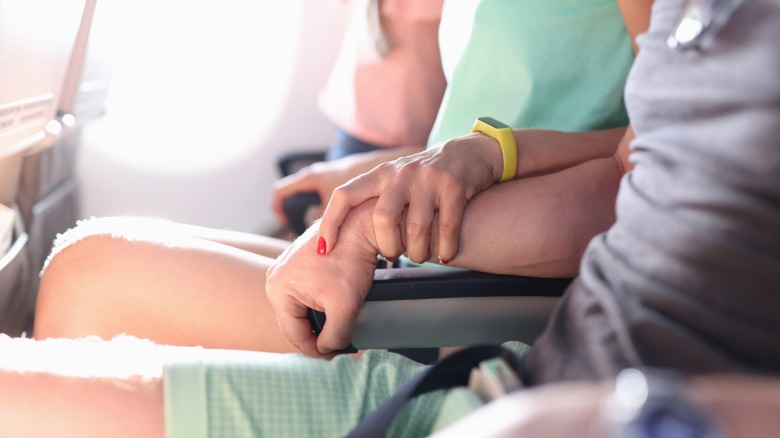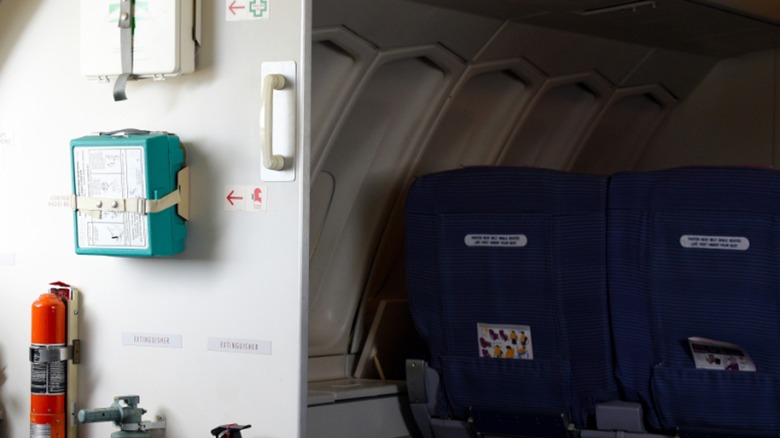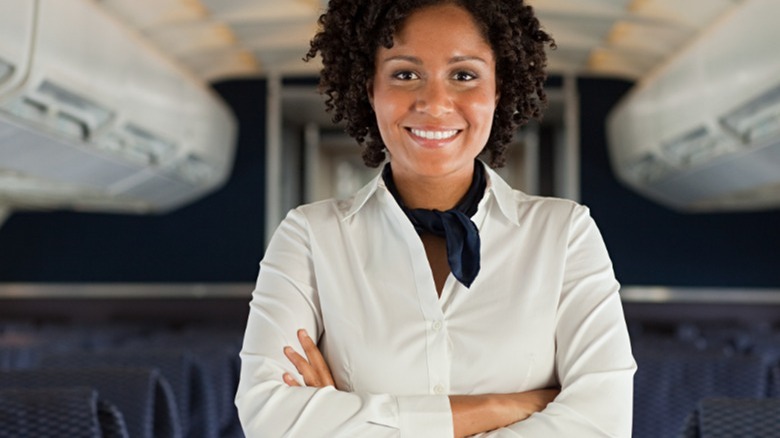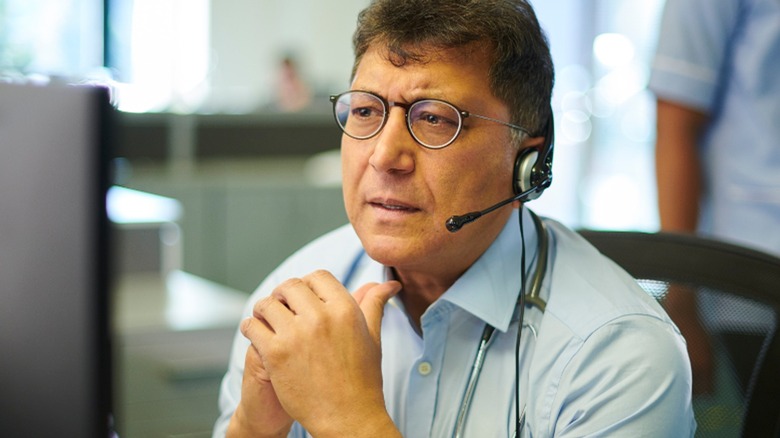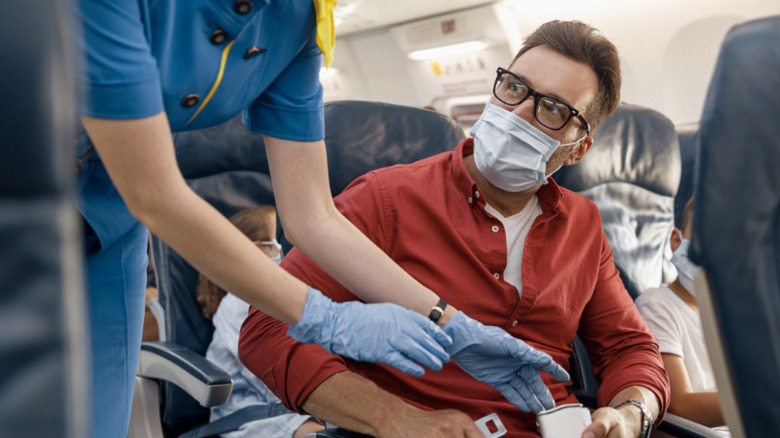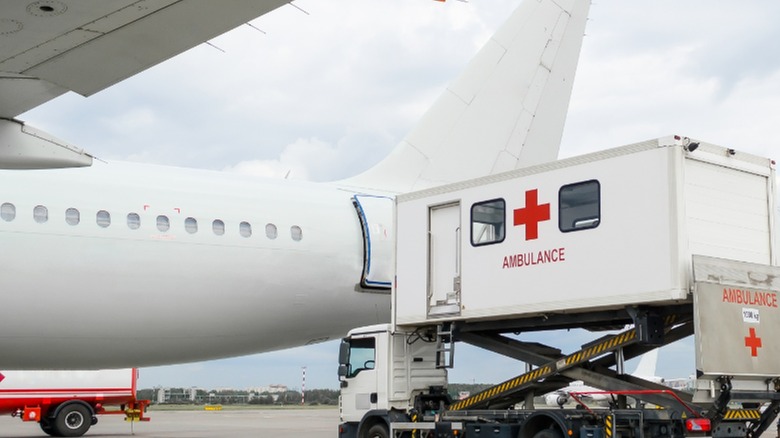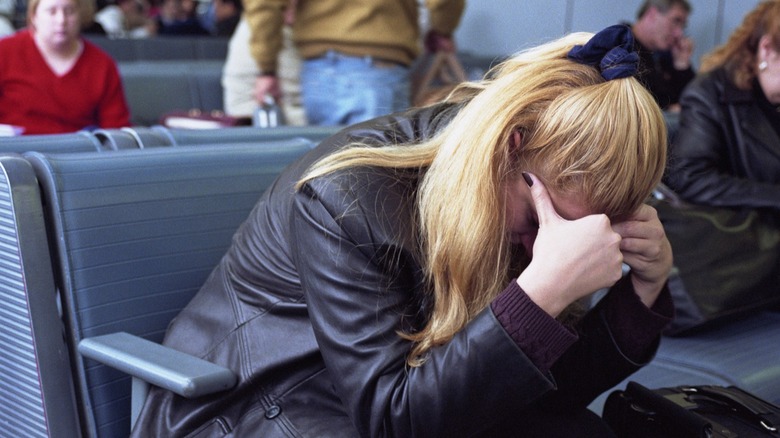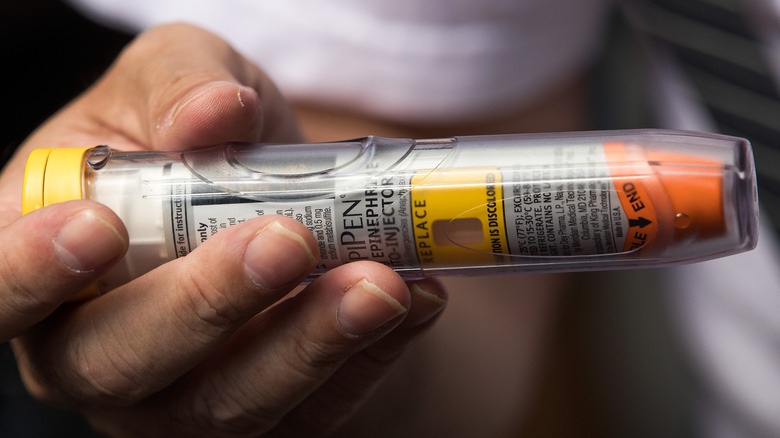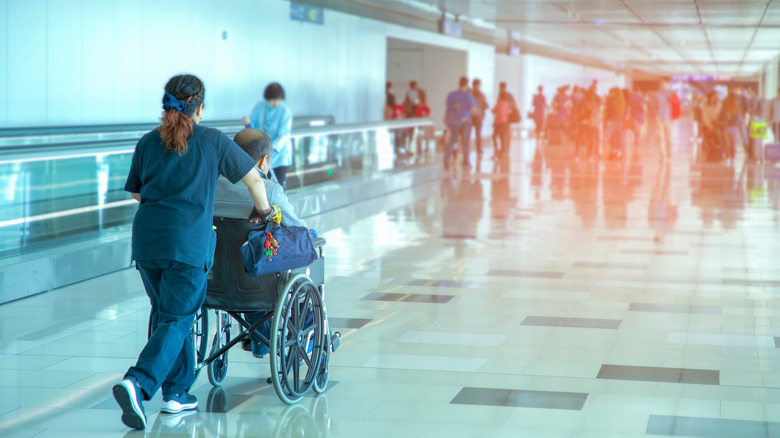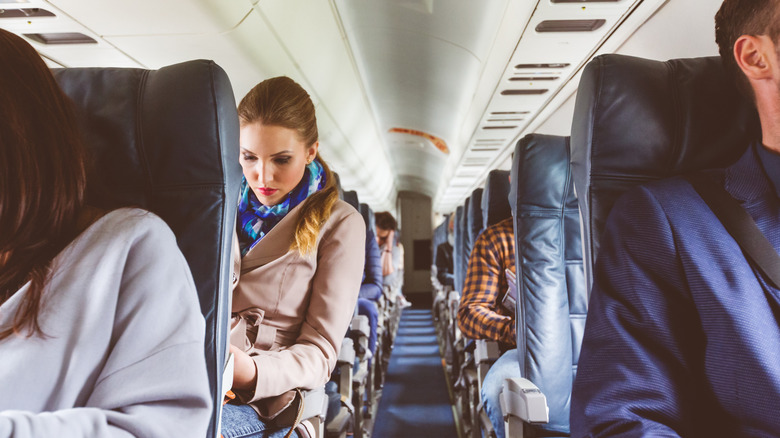What Happens If You Have A Medical Emergency On Your Flight?
The thrill of air travel often centers on the anticipation of reaching new destinations, but what happens when the journey takes an unexpected turn? After all, getting help at 35,000 feet in the air isn't exactly easy.
According to a study by the New England Journal of Medicine, in-flight medical emergencies transpire in one of every 604 flights. However, this study only included emergencies that needed "physician-directed medical communications." Although this statistic is thrown around a lot online, there is no internationally recognized classification for in-flight medical emergencies. Airlines and medical professionals favor the term "medical events" because most midflight health emergencies are manageable by the crew. In truth, an emergency probably happens more than you think.
But despite the severity level, everyone from the captain and the flight attendants to professionals on the ground and maybe even the person sitting next to you has important roles and makes pivotal decisions above the clouds. Training, collaboration, and available onboard medical equipment can all influence the outcome. So whether you're a seasoned traveler or embarking on your first flight, understanding the response to such an event — not to mention showing a little empathy — is essential to ensure your safety and the well-being of those around you.
What are the most common in-flight medical emergencies?
The most common medical emergency on a flight is syncope (fainting), making up about 32% of cases. Syncope happens when the brain doesn't get enough oxygen. While flying, people can faint because of changes in cabin pressure, getting up too fast, and anxiety. If someone faints, they are usually moved to the aisle, and their breathing and pulse are monitored. They'll lie on their back with their legs raised to help blood flow; sometimes, they will receive oxygen. Usually, people start feeling better within a few minutes.
Nausea, vomiting, and other stomach issues contribute to about 14% of in-flight medical events. However, if a contagious disease is suspected and at least three rows of seats are available, the passenger could be asked to move to distance themselves from the other passengers. A washroom might also be designated for the ill passenger only.
Respiratory, cardiovascular (e.g., chest pain), and trauma (e.g., from falling luggage) account for around 10%, 7% and 5% of emergencies but can usually be managed with onboard equipment and drugs like aspirin, oxygen, and basic CPR. Strokes, seizures, allergic reactions, and even cardiac arrest are reasons for only 1% to 5% of in-flight emergencies. Still, they are considered the most life-threatening due to the timing, lack of resources, and expertise needed to manage such an emergency.
What kind of medical equipment is on board?
While specific regulations depend on the local air authority, the Federal Aviation Administration (FAA) mandates commercial flights in the U.S. to have one or more first aid kits and AEDs, plus one emergency medical kit onboard with a list of required medicine and tools for the most common incidents. Emergency kits include items such as aspirin, syringes, tourniquets and even epinephrine for allergic reactions and dextrose to raise blood sugar levels.
Many airlines carry more than is mandated, such as diazepam in the event of an epileptic seizure, umbilical cord clamps for childbirths, and medicines such as nasal decongestants, ibuprofen, and antidiarrheals. Unfortunately, onboard medical kits may be insufficient, or the crew might lack the necessary expertise or licenses for life-saving interventions. For example, though epinephrine is present, flight attendants aren't trained to administer it, and auto-injectable EpiPens aren't included in the emergency kit. Not even aspirin or OTC medicine (in most cases) can be handed out without medical consultation.
For these reasons, in-flight emergency kits are also considered outdated. There is a push to update the equipment, but airlines have yet to make any significant changes. Delta only upgraded to medical-grade stethoscopes from disposable in 2022 after complaints it was near impossible to hear a heartbeat during an in-flight emergency. In June 2023, Congress members encouraged the House Committee on Transportation and Infrastructure to review the kit and make auto-injectors mandatory.
How well-trained are flight attendants?
Flight attendants aren't just killing time showing you how to wear an oxygen mask. They are trained to keep you alive. In the United States, cabin crew must undergo proper CPR training and demonstrate the use of an automated external defibrillator (AED), with evaluations every two years. During a medical emergency, the crew will assess the passenger using protocols such as DRSABCD (danger, response, send for help, airway, breathing, CPR, and defibrillation) and SAMPLE (symptoms, allergies, medications, past medical history, last meal, and events).
While they cannot handle every emergency, the good news is that, like angels in the sky, 70% of emergencies are managed by cabin crew through authorized medicine and simply by talking the passenger through it. Flight attendants are trained to comfort and empathize with passengers in distress. It's important to let them know if you fear flying. They are usually prepared for panic or anxiety attacks and might give you extra attention and try to keep you company.
Flight attendants interviewed by Reader's Digest revealed just how keenly aware they are. From the moment passengers are greeted on the plane, they notice fit people who can assist during an emergency and whether someone might need help or cause trouble — keep that in mind the next time they accidentally bump you with a drink cart. Nevertheless, they are not medical professionals. The crew will seek ground support and onboard medical volunteers if the emergency calls for skills outside their abilities.
What does ground support do during a medical emergency?
With the progression of technology, airlines have embraced remote emergency response centers, such as MedAire and the Mayo Clinic Aerospace Medicine program, that deliver 24-hour emergency assistance via satellite phones, radios, and apps from the ground. While the FAA doesn't mandate in-flight consultation, all the top airlines, and about 68% overall, use ground-based medical resources. Medaire alone receives 38 emergency calls per 1 million passengers in the U.S.
During a medical emergency, the crew informs the pilot, who initiates contact with the ground-based medical team and the airline's operations center, collectively choosing the course of action. These licensed medical professionals can authorize the crew to dispense medications and advise the captain to reroute the plane to the nearest medical facility or to stay on course. Because flight attendants are not trained to administer drugs or expected to know the correct dosage, they need licensed instruction before utilizing the emergency medical kit.
If a remote emergency response center is not available, the crew will likely seek onboard medical volunteers. Dr. Claude Thibeault, medical advisor to the International Air Transport Association (IATA), told The Atlantic that crews should contact remote medical centers before asking for onboard medical volunteers. Unfortunately, that isn't always the case.
Who can volunteer during an in-flight medical emergency?
Like in movies and T.V., if an emergency exceeds the crew's capabilities, they ask, "Is there a doctor on board?" And they mean any doctor. Heck, they mean anyone with a medical background. You don't get to choose on an airplane. Nurses, EMTs, paramedics, pharmacists — even a dentist might have experience with airways and breathing.
Your chances of having a medical professional on board are also good, given the one-in-604 statistic. Among these incidents, physicians were available for aid in 48% of cases and other healthcare providers in about 27%. Some European studies suggest 11-in-12 odds of having a doctor on board. Are you flying to Italy? That's even better, thanks to the country's frequent medical conferences.
Yet, expertise isn't guaranteed across the board. Studies reveal that onboard medical volunteers often felt ill-equipped to assist. Moreover, volunteer medical providers frequently neglect ground-support resources due to their unfamiliarity. Interestingly, volunteer healthcare providers tend to divert flights for medical events unnecessarily. Some professionals don't even know they can refuse to help. Despite ethical considerations, medical professionals in the U.S. have no legal obligation to intervene during an in-flight emergency. Medical volunteers are safeguarded by the Aviation Medical Assistance Act (AMAA), which shields volunteers responding to in-flight medical emergencies from liability on U.S. domestic and many international flights, except for "gross negligence or willful misconduct."
What if the plane needs to land?
There are no universal statistics for in-flight medical emergencies and diverted routes but from our one-in-604 figure, about 7% needed to change flight paths. Another study suggests anywhere from two to 13% of in-flight medical emergencies result in diverted routes. The choice to change the flight path is ultimately up to the captain. They will decide based on their received medical advice, proximity to the nearest airport, and whether it has the appropriate medical facilities.
However, there is more to consider. Commercial aircraft store surplus fuel in the wings for extra weight — which assists in keeping the wings from flexing during takeoff — not to mention the fact that, well, it's just cheaper. However, most commercial aircraft also don't have a method to fuel dump midflight. So if there's too much fuel, it might not be safe enough to land at the closest airport.
It's also worth noting that aircraft in these events are prioritized on the landing strip. Because this is considered an emergency landing, the airline is not responsible, and passengers are not compensated for the delay — unless they had the foresight to purchase traveler's insurance, and an emergency landing is covered. On the bright side, flights diverted due to medical emergencies typically have swifter recovery than nonmedical diverted landings, so other passengers should be back on their way relatively quickly.
How is a mental health emergency handled?
Despite psychiatric medical emergencies being rare — only accounting for 3.5% of reported incidents — they are more likely to disrupt flights. Mental health is already not widely understood by the general public, and, unfortunately, studies find that people are less forgiving of psychiatric emergencies. Hence, such incidents are more likely to elicit negative reactions than sympathetic ones.
The leading factor for psychiatric emergencies, accounting for up to 90% of cases, is stress. Stressors usually commence before takeoff, triggered by fear, security checks, delays, limited space, alcohol, and jet lag. Passengers may also experience withdrawal or have underlying psychiatric disorders. During mid-flight, these stressors can escalate, posing a significantly greater risk for everyone on board compared to situations on the ground. Passengers experiencing psychosis have been reported to have taken some alarming actions, such as trying to crash the plane or open cabin doors. Fortunately, this is exceedingly rare.
Each airline has its specific protocols, but in an in-flight medical emergency, the crew generally follows standard procedures, such as verbally de-escalating the situation, seeking assistance from ground support, and requesting onboard volunteers. However, if the passenger poses a threat, security protocols may require restraining the passenger or changing the flight's course. Restraint kits are sometimes found on flights and include tools such as zip ties and handcuffs. The FAA-mandated emergency medical kit also contains limited medications, including benzodiazepines, which induce sedation, and naloxone, which can reverse an opioid overdose.
How should at-risk passengers prepare for a flight?
While emergencies can strike anytime, passengers with a medical history should take steps to prepare, particularly when embarking on long-haul flights, like carrying essential medication and documentation, such as prescriptions and medical records. Most importantly, these passengers should contact the airline ahead of time.
For this specific purpose, airlines have forms called medical information forms (MEDIF), which give airlines vital details about a passenger's medical conditions or circumstances that could impact their safety. It also enables the airline to make necessary arrangements, like a stretcher or extra seating for medical tools (with associated fees), or if additional services are needed, such as special meals or wheelchair assistance.
A MEDIF is typically required to be submitted about 48 hours and no more than two weeks before the departure of each flight, depending on the airline. A MEDIF can usually be filled out and submitted online, but passengers may need to contact the airline's medical department.
Travelers with food allergies should be extra cautious, as allergic reactions are sometimes considered the most life-threatening IFME, primarily due to limited medical resources and personnel. Organizations like Food Allergy Research & Education (FARE) strongly recommend carrying at least two epinephrine auto-injectors when flying. Passengers can bring epinephrine on flights but should be prepared to show the drug's printed label, prescription label, and doctor's note. In the US, any over-the-counter liquid medications exceeding 3.4 ounces must be declared to a TSA officer, with some exceptions.
What is commercial medical support?
Commercial medical support refers to a personal, specialized service for passengers at risk who may require the presence of a nurse or other dedicated healthcare provider during their flight — especially if they are traveling on their own.
An in-flight healthcare professional's responsibility involves watching over the passengers' well-being throughout the flight, providing necessary assistance, and administering emergency medication and treatment if the situation arises. It is particularly relevant for elderly passengers and those with pre-existing medical conditions, such as chronic illnesses, that the cabin crew may not be equipped to handle.
As you can imagine, it's a costly service since, on top of healthcare, additional seats must be purchased for the escort and possibly equipment. For example, a flight stretcher, a specialized stretcher designed to fit in the space of regular cabin seats, typically occupies the space equivalent to about six or more seats and thus generally costs the same as if the passenger purchased six seats on a flight. Insurance may cover a medical escort and any surcharge, but it will depend on specific coverage.
What happens when someone dies?
In the study published in the New England Journal of Medicine, death was extremely rare, accounting for only 0.3% of cases. Still, airlines maintain protocols to address an in-flight death. However, these procedures are not industry-wide. The Federal Aviation Administration (FAA), the US government agency responsible for regulating air travel, mandates that death be reported appropriately.
Beyond this, there are only recommendations. For example, the FAA suggests that the flight crew or a medical professional perform CPR for at least 30 minutes if feasible. Once resuscitation is believed to be impossible, the pilot, based on suggestions from ground support or a medical volunteer, will decide whether to divert the flight and, more than likely, it won't. After all, there isn't technically an emergency anymore.
The IATA suggest returning the deceased to their seat, ideally away from other passengers. The body may also be relocated somewhere discreet but will be secured in a seat during the landing. On crowded flights, it may be unavoidable to move the body. In this case, passengers may find themselves seated beside the deceased or request, if possible, a seat change to crew seating during the landing.
The IATA also advises using a body bag when available (sometimes found in emergency kits). Otherwise, they recommend "closing the passenger's eyes and covering the body with a blanket up to the neck." By this point, the emphasis is on other passengers' experience and being as respectful as possible.
What should other passengers do?
Regular passengers (i.e., non-medical volunteers) should maintain composure and follow the crew's instructions. If you notice someone who needs aid, you should calmly alert the crew. Panic will only make the situation worse.
Indeed, your reaction might set the stage for the entire ordeal. According to the CDC, effective communication during a crisis can save lives, prevent injuries, and alleviate emotional trauma during challenging situations.
Of course, no one wants their flight disrupted, but try empathizing with the affected person, their family, and the crew. For example, if you are seated next to someone who experiences flight-related anxiety, which can trigger medical emergencies, offering a sympathetic ear can go a long way in easing their distress. According to the Mayo Clinic, a nonprofit dedicated to clinical research, having a friend can boost confidence and reduce anxiety. Nevertheless, unless asked to volunteer, the crew won't expect you to assist, and even then, you shouldn't feel obliged — decline so that they can direct someone else.
